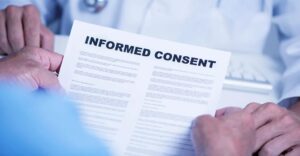Venlafaxine
Unlike selective serotonin reuptake inhibitors (SSRI) antidepressants like fluoxetine, which work primarily on serotonin, Venlafaxine acts on other serotonin receptors. Venlafaxine acts via two different mechanisms. It presumably functions by modifying the brain’s neurotransmission of two important neurotransmitters, norepinephrine and serotonin.
One neuron releases neurotransmitter into the space between it and the subsequent neuron during neurotransmission. The neurotransmitters interact with receptors, which are particular locations on the surface membrane of neurons. After then, an electrical impulse is created from the chemical signal that causes more neurotransmitter release as it passes through the cell. Along a chain of neurons, this neurotransmission process is repeated. Following the release of neurotransmitters and the start of neurotransmission, after a chemical signal is sent to neurons, a process known as reuptake returns the neurotransmitters to the brain’s cells. By preventing the neurotransmitters from returning to their original locations inside the neurons, were produced, the neurotransmitter’s effects may be amplified by the antidepressant.
Venlafaxine primarily works as an antidepressant by preventing serotonin and norepinephrine from being reabsorbed. While Venlafaxine’s mechanism of action is similar to that of SSRIs, it differs significantly in that it also prevents nor-epinephrine from being reabsorbed. Venlafaxine increases norepinephrine and serotonin neurotransmission by blocking reuptake.
Venlafaxine is referred to be a serotonin-norepinephrine reuptake inhibitor (SNRI) as a result. Serotonin, norepinephrine, or both may be neurotransmitter at unusually low levels, which may lead to depression and other mental illnesses. Affected brain regions may undergo alterations as a consequence of this anomaly, giving rise to psychological symptoms like anxiety or sadness. When the antidepressant enhances neurotransmission, the disease’s symptoms are lessened as the damaged brain regions resume their regular functions.
Only Venlafaxine XR is licensed by the FDA to treat panic disorder, social phobia, and generalized anxiety disorder. Venlafaxine and Venlafaxine XR are both approved to treat depression.
- Medical professionals may also recommend Venlafaxine and Venlafaxine XR to treat attention deficit/hyperactivity disorder, premenstrual syndrome, and posttraumatic stress disorder. Venlafaxine has also shown promise in the treatment of melancholic melancholy in people who are more severely depressed and may not react as well to other antidepressants.
Information about Dosing
There are two forms of Venlafaxine available: Venlafaxine tablets with immediate release and Venlafaxine XR capsules with prolonged release. Since the extended-release version of Venlafaxine allows for once-daily dosage and may be more tolerable than the immediate-release pill, doctors often prefer to prescribe medication in the extended-release form.For the immediate-release tablets, this means taking two or three split doses; for the extended-release capsule, it means taking one dose per day. The suggested beginning dosage is 75 mg/day. Some people may handle Venlafaxine XR better with a beginning dose of 37.5 mg/day, particularly those who are elderly or have ongoing medical conditions.
Dose increases that followed, up to 75 mg daily. After a further week or two, the dose may be raised to 150 mg/day, depending on clinical response and tolerability. Additional dose increases are applied gradually as required. Venlafaxine XR dose range for outpatient treatment of mild depression is typically 75–125 mg and 225 mg every day. Higher dosages may be required for depression that is more severe and resistant to previous therapies. Venlafaxine 375 mg daily and Venlafaxine XR 225 mg daily is the typical maximum dose.
Typical Side Effects
Venlafaxine side effects that occur most often include nausea, vomiting, dry mouth, jitters, and anxiety, headaches, vertigo, and sleeplessness. Usually, side effects start to show up when the medicine is started or when the dose is increased. The doctor may lower the dose if side effects become severe so that the patient may get used to the drug before gradually raising it once again.Venlafaxine causes sexual adverse effects, such as delayed ejaculation in males and delayed orgasm in women, at a rate that is similar to that of the SNRI antidepressant (duloxetine), but lower than the SSRI-related incidence of 50%–60% reported.
Adverse Events and Safety Measures
About 5% of people on regular Venlafaxine doses may have moderate hypertension, or elevated blood pressure. The frequency of Venlafaxine-induced hypertension may increase with larger doses.The majority of people seldom need to stop taking Venlafaxine due to hypertension, and blood pressure is often moderate. Lowering the dose will usually cause the blood pressure to return to normal. Because of this, patients’ blood pressure has to be examined as a precaution before beginning Venlafaxine and on a regular basis while on medication, particularly for people who already have high blood pressure or a history of heart disease.
Some individuals may experience sleepiness with Venlafaxine. Until they are convinced that their medicine is not impairing their attention or coordination, patients should refrain from using equipment or driving. Venlafaxine should not be used by patients who have a history of severe side effects or who have a known allergy to the drug.
Use of Venlafaxine during pregnancy and lactation: Category C Pregnancy
Venlafaxine’s safety during pregnancy has not been investigated in female subjects. It is uncertain how the drug will affect the growing fetus. Pregnant or potentially pregnant women should talk about this with their medical professional. When they stop taking their antidepressant, some women may have a relapse of depression. In these situations, it could be essential to resume the medicine or look for a different kind of drug or care.
Venlafaxine should not be used by nursing women since minute quantities may enter the breast milk and be consumed by the unborn child. Breastfeeding should not begin or should be stopped if quitting the antidepressant is not an option.
Potential Interactions with Drugs
Like many other drugs, Venlafaxine is processed by the liver. The co-administration of certain drugs might lead to harmful drug interactions as one medicine can change the other’s blood levels. Fortunately, there aren’t many documented medication interactions with Venlafaxine.
- When used with Venlafaxine, other drugs that increase serotonin, such as herbal supplements like St. John’s wort, may cause an excess of that neurotransmitter and result in serotonin syndrome, a hazardous condition. Serotonin syndrome’s first symptoms include tremors, flushing, restlessness, and bewilderment and uncontrollably jerking muscles.
- If the drugs are not discontinued, the patient may have further potentially fatal side effects such as muscular weakness, a high temperature, breathing issues, blood clotting issues, and red blood cell decomposition, which might result in abrupt renal failure. Venlafaxine users should be aware of the potential symptoms of serotonin syndrome, which call for stopping the serotonin-boosting drugs and seeking emergency medical assistance.
- Cimetidine, or Tagamet, Tagamet could prevent Venlafaxine from being metabolized.
Venlafaxine levels may rise as a consequence, which might exacerbate unfavorable side effects. This combination should be used with strict monitoring of blood pressure. - SSRIs, or selective serotonin reuptake inhibitors, Venlafaxine’s metabolism may be inhibited by SSRIs, especially Paroxetine, which might raise blood levels of the medication.
When using this combination to treat resistant depression, it’s important to regularly monitor blood pressure. Patients must be kept under observation as well for serotonin syndrome symptoms. - TCAs, or tricyclic antidepressants When used with Venlafaxine, the levels of TCAs may rise, which might exacerbate the TCA’s negative side effects. Additionally, patients need to be kept an eye out for serotonin syndrome symptoms and indicators.
Haloperidol, or Haldol Venlafaxine may decrease Haldol’s clearance and raise its blood levels, which might exacerbate the antipsychotic’s adverse side effects.
Monoamine oxidase inhibitors (MAOIs), a class of antidepressants, and Venlafaxine should not be used combined since this may result in a hazardous response that includes high body temperature, high blood pressure, as well as heightened anxiety and excitement. Before starting any new medicine, including over-the-counter drugs and herbal supplements, patients should speak with their doctor or pharmacist about Venlafaxine.
- Alcohol should be avoided or used in moderation by patients on Venlafaxine since the combination may make depression worse.
Overdosing
Venlafaxine overdose is often much less harmful than that of tricyclic and MAOI antidepressants, particularly when taken alone. When taking numerous drugs, patients are more likely to overdose, and this raises the possibility of more significant side effects. When Venlafaxine is used with central nervous system depressants (such as alcohol, drugs, or benzodiazepines), the result may be fatal respiratory depression.
Venlafaxine overdose reactions have been reported to include changes in consciousness (from somnolence to coma), rapid heartbeat, seizures, vomiting, arrhythmia, low blood pressure, liver damage, serotonin syndrome, and death, depending on the amount consumed and whether the medication was combined with alcohol or other drugs.
- Treating any suspected overdose as an emergency is imperative. The individual has to be brought to the emergency space for care and observation. It is advisable to include both the prescription bottle of medicine and any other medication suspected in the overdose, since the information on the label may be useful in helping the treating physician figure out how many tablets the patient has taken.
Precaution Points to Remember
Major depressive disorder may often be effectively treated with medication, psychotherapy, or both. For the treatment of moderate to severe depression, the combination of psychotherapy and antidepressants is particularly successful. Medication enhances mood, energy, sleep, and appetite, while therapy helps people develop coping mechanisms, addresses any potential underlying problems and enhances behavior and mental habits. Venlafaxine may be quite helpful in the treatment of anxiety as well.
60% to 70% of those who take antidepressants on their own report feeling better overall. The majority of people do not see noticeable advantages from their antidepressants until after 3–4 weeks, and it may sometimes take up to 8 weeks for the medicine to have its full effects. A small percentage of people may notice some improvement before the end of the first week. Therefore, it is crucial that patients take their antidepressant for the whole recommended amount of time and that they do not give up and stop taking it too soon if they do not start feeling better right away.
Antidepressants have been shown in short-term trials to raise the likelihood of suicidal thoughts and actions in kids and teenagers suffering from severe depressive illness and other mental health issues. When beginning antidepressant treatment in children and adolescents, the FDA mandates that the prescriber disclose this risk to the patient.
According to FDA research, there is an age-related risk of suicide thoughts and actions while using antidepressants. This phenomenon is more likely to manifest early in the course of and is more common in the younger population.
- Antidepressant use did not seem to be associated with a higher incidence of suicidality in people over the age of 24, as compared to placebo use. The results demonstrated that antidepressants have a “Protective effect” against acts and ideas of suicide. Additional research has shown that When antidepressants are used by a population, the suicide rate decreases.
- Suicide risk is a part of depression and might last until the patient responds to therapy. Upon beginning or discontinuing an antidepressant treatment, the patient especially a child or adolescent should be regularly watched for increasing symptoms of depression, and the patient’s family or caregiver should alert the doctor to any concerns.
- Caution: If you have suicidal thoughts, always inform your doctor or a family member. Notify your family doctors or psychiatrist if you have worsening depression symptoms or if you find it difficult to resist thoughts or desires to end your life.
- Avoid stopping Venlafaxine suddenly. It is best to reduce your dose gradually in order to avoid the symptoms of withdrawal.
- If you forget to take a dosage, catch up by taking it two to three hours later than planned. If it’s near the Skip the missed dosage and resume your usual dosing regimen for the next scheduled dose.
- Never take two doses at once.
- Keep Venlafaxine out of heat and moisture and in its original, labeled, light-resistant container to minimize gastrointestinal adverse effects when taking it with meals. Your drug may break down more quickly in hot and humid environments, losing its therapeutic benefits.
- Make sure kids can’t get to your medicine.




